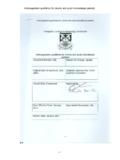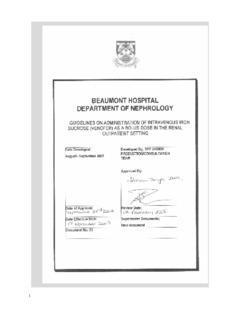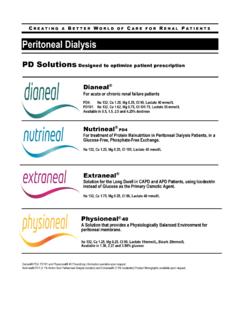Transcription of DEPARTMENT OF RENAL NURSING PROTOCOLS …
1 DEPARTMENT of Nephrology peritoneal dialysis protocol & Procedures Beaumont Hospital January 2009 1 DEPARTMENT OF RENAL NURSING PROTOCOLS AND PROCEDURES peritoneal dialysis Version Number: 3 Reason for change: Update Date Developed: April 07 Feb 08 Developed By: Dr. Neal Morgan, Johanna McWilliams CNM2, Norah McEntee CNM1, Original Date of Approval: February 2008 Originally Approved By:Ms. Sharon Dwyer DNM, Prof. Conlon and DEPARTMENT of nephrology policy committee. Recent Date of Approval: 20th January 2009 Approved By: DEPARTMENT of nephrology policy committee Original Date Effective From: February 2008 Date Effective From: 20th January 2009 Review Date: February 2010 Document Number: 2 Superseded Documents: 1 Date Review No. Change Ref. Section Jan 2009 1 Policy updated Additional appendix ,appendix1. Appendix 2 (new) DEPARTMENT of Nephrology peritoneal dialysis protocol & Procedures Beaumont Hospital January 2009 2 PRODUCTION AND CONSULTATION TEAM Johanna McWilliams CNM 2 peritoneal dialysis Unit Petrina Donnelly Clinical Practice Support Nurse, RENAL Unit Norah McEntee CNM1 peritoneal dialysis Unit Eleanor Tierney Staff Nurse peritoneal dialysis Unit Lorraine Carroll Clinical Nurse Manager 2, Hamilton Ward Maureen McNulty Clinical Nurse Manager 2.
2 Peters Ward Sharon Dwyer Divisional Nurse Manager - RENAL Professor Peter Conlon Consultant Nephrologist Professor Joseph Walshe Consultant Nephrologist Sheila Donlon RENAL Virology Co-ordinator Dr Neal Morgan Consultant Neprologist Dr Colm Magee Consultant Nephrologist DEPARTMENT of Nephrology peritoneal dialysis protocol & Procedures Beaumont Hospital January 2009 3 TABLE OF CONTENTS Aim/Purpose of policy pg 4 Scope of Policy pg 4 Definitions pg 4 Responsibilities pg 4 Procedure Pre-op care for Tenckhoff insertion pg 5 To Flush a Tenckhoff Catheter on Insertion pg 6 Exit Site Care for a Tenckhoff Catheter pg 7 Performing a Manual Exchange pg 8 Disposal of peritoneal dialysis Effluent pg 9 Care Of Patient with Peritonitis pg 11 Change of Transfer Set pg 12 Change of Titanium Adaptor pg 13 Removal of Transfer Set pg 14 Procedure for Intra- peritoneal pg 15 administration of medications.
3 Distribution pg 16 Filing pg 16 Review pg 16 Superseded/Obsolete Documents pg 16 Appendix 1 Recommendations for IP medication dosage pg 17 Appendix 2 Advice on antibiotic prescribing pg 18 Reference List pg 27 DEPARTMENT of Nephrology peritoneal dialysis protocol & Procedures Beaumont Hospital January 2009 4 Aim/Purpose of policy The aim of this document is to provide up to date guidelines for care of patients on peritoneal dialysis therapy. The objective is to ensure that the multidisciplinary team is providing a uniformed approach to practice which is underpinned by evidence based practice. Scope of Policy This policy refers to all medical and NURSING staff in the RENAL area in Beaumont Hospital. All members of the multidisciplinary team are accountable for the care they deliver. They are required to base their practice on the best available evidence identified by research in order to provide effective, safe patient care.
4 Definitions peritoneal dialysis (PD) is a treatment that uses a natural membrane in the body for fluid and solute exchange. The goals of the therapy include removal of waste products, management of fluid, and regulation of acid base and electrolyte imbalances. To achieve these goals a dialysing solution (dialysate) is instilled into the peritoneal cavity for a period of time known as a dwell period. Following the dwell period the fluid (effluent) containing substances such as urea, creatinine, electrolytes and amino acids is drained and replaced with fresh dialysate. In order for this treatment to work the patient requires a tenckhoff catheter to be inserted into the peritoneum cavity. Within these guidelines, nurses will find information required on the overall management of tenckhoff catheters and peritoneal dialysis . Responsibilities Each nurse is professionally guided by An Board Altranais particularly by The Code of Professional Conduct (An Bord Altranais, 2000).
5 Members of the multidisciplinary team must acknowledge any limitations of competence and refuse in such cases to accept delegated functions. DEPARTMENT of Nephrology peritoneal dialysis protocol & Procedures Beaumont Hospital January 2009 5 Procedures PRE-OP CARE FOR TENCKHOFF INSERTION Procedure PD Staff to be contacted by medical staff when patients scheduled for theatre for tenckhoff insertion Swab the nose and umbilicus for culture and sensitivity, results required pre-op Administer bowel prep as prescribed unless otherwise stated by surgeons the day prior to surgery, and record result (Lancaster 2001 p. 343) Patient must fast from 12 midnight pre op (Lancaster 2001 ) Ensure patient has a hibiscrub shower the morning of the procedure Prophylactic IV Antibiotics to be administered on morning of theatre as prescribed (Beaumont policy as of June 2009) Teicoplanin 400mgs (if no allergies noted) on morning of theatre (Kredit et Al 2002 , Lancaster 2001 ) Ensure bladder is empty on the morning pre theatre (Lancaster 2001 ) Prepare Patient for theatre as per Beaumont Hospital checklist DEPARTMENT of Nephrology peritoneal dialysis protocol & Procedures Beaumont Hospital January 2009 6 Procedure for Flushing a Tenckhoff Catheter on Insertion.
6 (Lancaster 2001 ) Indications: To assess the patency of the Tenckhoff Catheter on insertion to ensure fluid inflow and outflow is adequate. Equipment: (For the PD nurse outside sterile field) 2 Litre bag of Extraneal (Warmed) PD Transfer set Blue Clamps PD bag weighing scales For the theatre nurse (On sterile field) * Quinton Tenckhoff peritoneal dialysis catheter with two cuffs Titanium accessory catheter adaptor 125cm long wide bore extension set PD Transfer set Minicap Procedure PD nurse attends theatre as the patient is prepared by the surgeon The PD nurse connects the Warmed extraneal with the transfer set. Once the tenckhoff is inserted the surgeon attaches the titanium adaptor to the tube The end of the extension set is passed to the PD nurse Once primed the surgeon attaches the extension tube to the Tenckhoff. Approximately 400mls is flushed in and out as per surgeon s Instructions.
7 The extension tube is then disconnected by the surgeon and the transfer set and minicap is applied The PD Nurse clamps the dialysis bag. The PD nurse weighs the fluid as it goes into the peritoneum and the drain bag is weighed post procedure. Equipment is disposed of in the theatre sluice room as per disposal policy. The tenckhoff insertion is documented on clinical vision and in the PD diary and the patient kardex by the PD nurse. The nurse then replaces all items in the theatre bag. DEPARTMENT of Nephrology peritoneal dialysis protocol & Procedures Beaumont Hospital January 2009 7 EXIT SITE CARE FOR TENCKHOFF CATHETER (Lancaster 2001 p348) Equipment required Gauze Squares (Sterile) Chlorhexidine Sachet Mepore dressing 9x15 (2) Sterile Gloves Procedure The dressing should be performed by a competent Nurse in this area.
8 Initially post op leave dressing undisturbed unless medically indicated. Advise patients not to shower or bath for two weeks post-op (ISPD 2005 ) Dressing renewed on day 5 and day 10. (Kredit et AL 2002 ) Thereafter dressing renewed every second day and after every shower Wash hands as per protocol . Wash down worktop area with teepol solution (patients use soap and water at home) and clean with a hard surface wipe. Open gauze pieces and mepore dressing onto their packs on the worktop. Keep one gauze piece dry and apply chlorhexidine (unisept) to the other four pieces. Remove old dressing (if not already removed at the end of your shower). Apply hand gel (ISPD 2005 p110) Take up the gauze using the parachute method, clean around exit site in one direction with chlorhexidine gauze. Repeat this action with the other three pieces. With the last piece of gauze clean the tube from the exit site and discard piece.
9 Take dry piece of gauze and dry around the site. Remember bacteria grow on heat, moisture and light. Apply new dressing flat to surface. Do not key hole cut. Catheter must be anchored to skin. (ISPD 2005 ) DEPARTMENT of Nephrology peritoneal dialysis protocol & Procedures Beaumont Hospital January 2009 8 Performing a Manual Exchange Equipment Hard surface wipes 2 connection shields. 2 Minicaps/disconnect caps 2 Blue clamps. Hand gel Warm Bag of dialysate fluid. Procedure Wash hands as per protocol Wash down worktop with Teepol solution, Patients can use soap and water and home Clean with a hard surface wipe, cleaning in one direction only, covering the entire surface. Open bag lay on table Check for Clarity. Volume. Concentration Expiry date (e) Leakage.
10 Pull bag lines free. Lay table with all of the above requirements (7 in total) Open connection shield Apply hand gel Apply connection shield to the end of tubing on the bag Remove cap from your tube and connect yourself to the bag Open roller clamp and drain. When drained out, close roller clamp. Break green seal on full bag line count to 15 to allow flush from full bag to drainage bag. Clamp drainage bag line. Open roller clamp to fill. When filled, clamp bag line. Close roller clamp and apply a clamp to the fill line. Open disconnect cap Apply hand gel Disconnect yourself and put new cap on DEPARTMENT of Nephrology peritoneal dialysis protocol & Procedures Beaumont Hospital January 2009 9 DISPOSAL OF peritoneal dialysis EFFLUENT. (DOHC 2004 ) Hospital policy Procedure Staff must wear gloves and apron when handling effluent at all times Ensure clamps are on bags before leaving the patients bedside.










